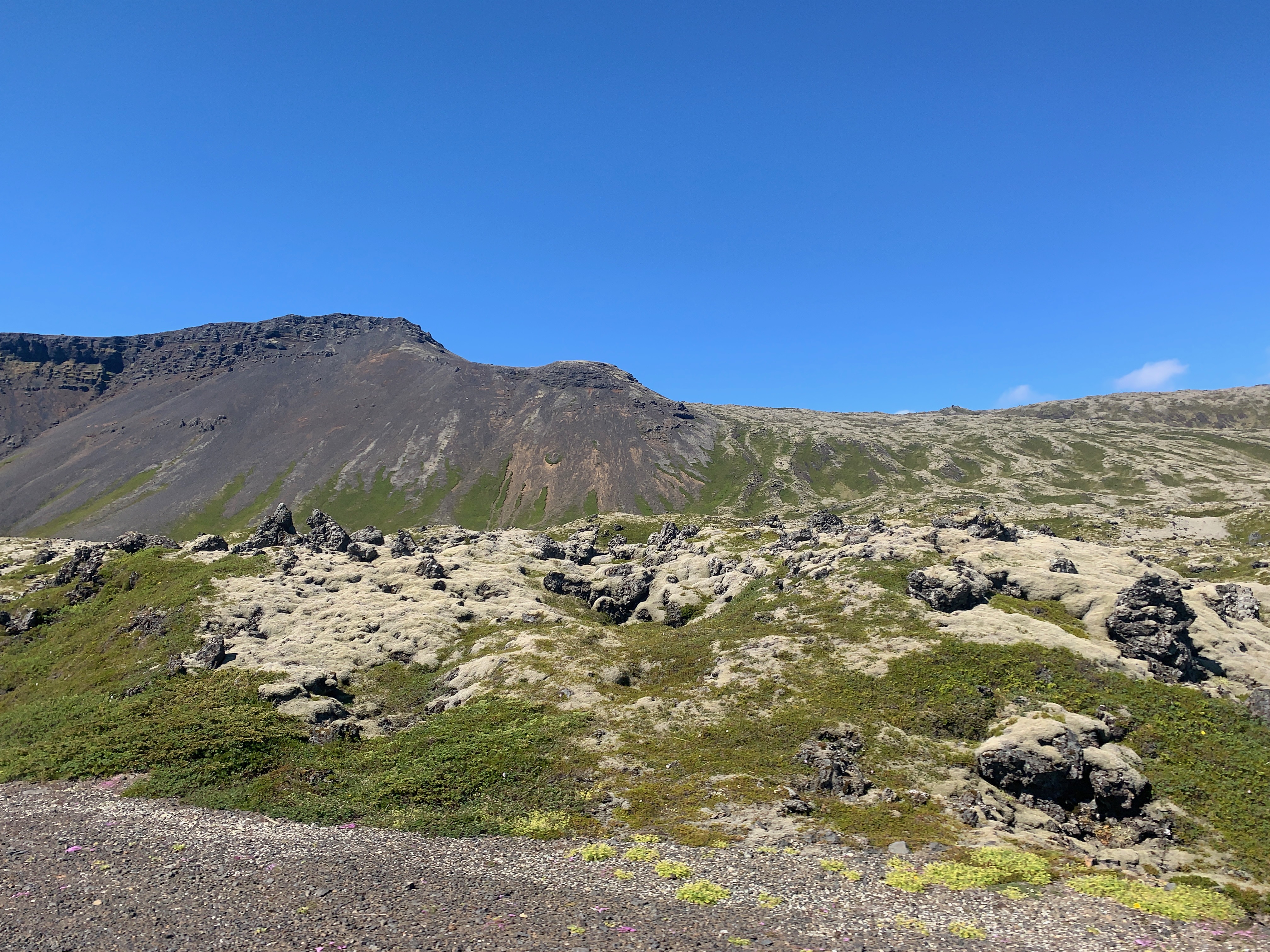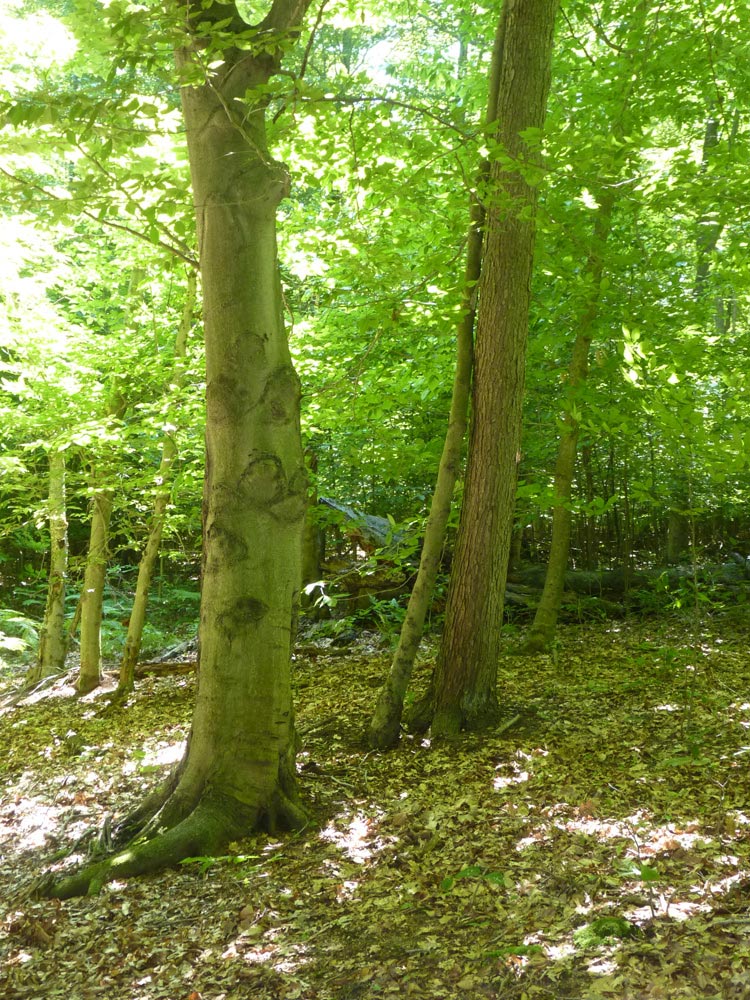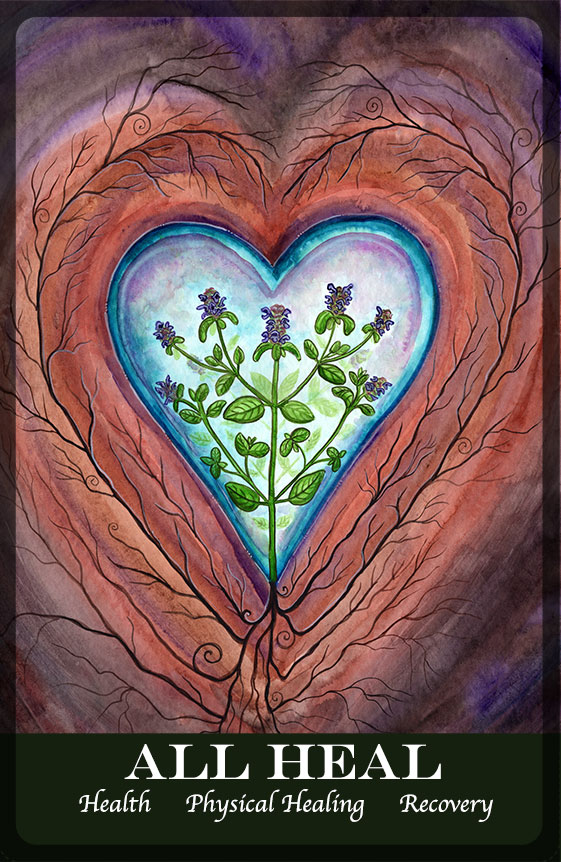
Ecological succession is nature’s approach to healing. From bare rock, ecological succession allows forests to eventually grow. Ecological succession has much to teach us as a powerful lesson from nature, and it is a particularly useful thing to meditate upon during the pandemic. As we can look to how nature heals, it offers us guidance and stability during this challenging time. Thus, today’s post introduces the idea of ecological succession and how these lessons can be helpful to us as spiritual lessons for thought and reflection. This post is part of my land healing series. For earlier posts, you can see a framework for land healing, land healing as a spiritual practice, a ritual for putting the land to sleep, and a primer for physical land healing.
Ecological Succession
Because nature works on larger time scales, its not always obvious that nature is engaging in healing and transformative work in every moment, all across the land. We are seeing this even with the shifts in human behavior during the pandemic: sea turtles coming up to lay eggs on abandoned beaches, air pollution levels going down, oceans and waterways clearing. These processes are part of nature’s great power, much of which is driven by the process of ecological succession.
All of nature works towards “ecological succession”, a process by which an entire ecosystem changes and grows, eventually reaching something called a climax community. Climax communities are stable ecosystems that have a diversity of species, nutritional and energy balance, tolerant of environmental conditions, the kinds of species are stable and do not change. This ecosystem thus is diverse, tolerant of diverse climate conditions, and abundant. Climax communities obviously look very different in different ecosystems, bioregions, and parts of the world. A tropical rainforest is one kind of climax ecosystem, as are boreal forests, tundras, deserts, and more. You can find these by visiting parks that have old-growth forests or other longstanding natural features.

Primary Succession. To start from the very beginning, in what is called primary succession, we might have bare rock with no soil, such as those situations left by the retreat of glaciers, lava formation, recently-formed sand dunes, or even boney dumps from old mining sites like we have around here. So we start with bare rock–and rock itself, while it is part of soil, is not soil and does not contain organic matter that plants need to grow. So ecological succession begins with the lichens who slowly break down the rocks and helps form soil. This process can take a very, very, very long time (centuries or millennia). Once we have soil, we have small annual plants and lichens, giving way to perennial grasses and flowers. At this point, our bare rock has turned into a field and the more that grows, the more organic matter is produced, allowing for a richer organic basis for larger plant life. Most of this kind of ecological succession was done in the time of our ancient ancestors, and so we usually start with the point where we have soil, perhaps a lawn of grass, or like our opening example suggested, an empty field that has been over-farmed.
Secondary Succession. Once the soil is established, this is where we get into the second kind of ecological succession: secondary succession. Secondary succession is what has happened in the example I shared above – a forest was removed for farmland, and now the farmland is ready to return to forest. Secondary succession is typically what you are dealing with as a land healer, as the scale for this can be within one’s lifetime and we can see nature’s regrowth even in a few short weeks or months.
To explore this process, we might consider what would happen if a person stopped mowing their lawn. If this person lived along most of the Northeast part of the US, ecological succession would eventually move that lawn to a Northern Hardwood Forest, the pinnacle ecosystem in this region. Immediately, the grasses would grow tall along with any other plant life currently inhabiting the lawn, like ground ivy, docks, plantain, dandelion—most of these “pioneer” species are well adapted for growing in disrupted ecosystems. Within the first few years, we’d see seedlings from shrubs and trees that are shade intolerant wold take root (red maple, black birch), spread by the wind, birds, and animals. We’d likely see autumn olive (which spreads quickly), birch, aspen, staghorn sumac, and lots of blackberry, raspberry, and other rhubus species moving in. For a long time, this lawn would be a field populated by sun-loving annual and perennial plants, but with each year, the trees and shrubs would get taller. As these plants started producing seeds, berries, and foliage, animals, including larger animals, would return as there would be food for them to eat.
If you were walking through this piece of land when it was a wild field in mid-succession, you might not realize the rich history of the land before you. You might also not realize the powerful, yet quiet process you are witnessing as the land returns to its most abundant state. Ecological succession and forest healing is a long process, well outside the human lifespan. Yet nature’s healing is there, we only need to know what to look for. If you returned to this place again and again and perhaps scattered some seeds and popped some acorns and walnuts in the ground, you’d see this transformation over a period of years would learn a lot about how nature heals. You’d also find spiritual healing for yourself in this place.
Eventually, those tree seedlings in the field would start to grow tall, discouraging full sun perennials and grasses and shifting to part shade as the trees filled out their crowns. Within 50 years, depending on local conditions, the tree canopy would cover the entire area, allowing the soil to retain water and cooling the temperature on the ground. Woodland, shade-adapted species would then dominate the forest floor.

Within about 150 years, the canopy would change from short-growing trees (maples, birches, cherries) to longer-growing trees (oaks, hickories, walnuts, butternuts, maybe even chestnuts), as smaller trees wait underneath the forest canopy for a break in the canopy. offering more long-lived hardwoods, and reach the end of ecological succession—the climax community of oak, hickory, and other hardwoods with a rich and diverse understory (pawpaw, hawthorn, serviceberry, sassafras, spicebush, etc). Thus, it is not a single species that cause ecological succession, but rather, an entire community of species working together in an interconnected web of life–one coming after another, until we the forest once again reaches the climax ecosystem.
Where I live, the only places that are at their climax are ones under some kind of permanent and long-term protection: state parks, conservation areas, or other protected lands. If you enter these places, you’ll, of course, notice the energy first: they are calm, restful, very vitalizing places to return to again and again. They are vibrant, alive, and functioning at their peak. Everything in the ecosystem is cycled in perfect balance.
Spiritual Lessons of Ecological Succession
Ecological succession is nature’s primary driving force for healing the land and ecosystems. It’s a powerful process that has shaped this land again and again. Thus, I think it is a critically useful thing to understand, interact with, and meditate upon. It offers us numerous lessons, some of which I will share here (with many others ready to discover). I also think these lessons are particularly relevant and valuable to us during the time of the pandemic when so much disruption is at play.
Disruption is a natural part of life. That nature is so good at adapting, healing, and ecological succession suggests that disruption is part of life here on earth. It is part of the life of a forest as much as it is a part of the life of a human. If we apply this same issue to our own lives, we may have minor disruptions (selective logging) or major disruptions (lava, forest fires, etc). These disruptions cannot heal overnight, but we will heal.
This is a particularly valuable lesson for us right now. Most of us are experiencing a major disruption in our lives–on a cultural scale, probably the largest we have ever seen. Nobody knows what the new normal will be or how long the disruption will last. But this lesson from nature is clear–disruption is a powerful opportunity for new growth.
Healing Begins immediately. As soon as the disruption ends, healing begins immediately. If you’ve ever been to a fire-dependent ecosystem, within 1-2 weeks of the end of the fire (or after the first good rain), you’ll see tiny little seeds sprouting and plants coming to life. This, too, is part of nature’s healing process. It will take time for the ecosystem to return to the state before disruption, but it will. Having faith in that process is the start of the healing process. Perhaps our own healing has already started, and we don’t even know it!
Healing takes time Nature reminds us that healing takes the time it is going to take, and there is no rushing the process. From lava to mature forest could take 1000 years or more. When I visited Iceland last summer, we saw the lichen-encrusted lava fields, looking like piles of green. Some of them had names tied to historical events in the middle ages or before–some of them were thousands of years old, and due to Iceland’s extreme climate, it would take a few thousand more years for anything else to grow. This was nature’s healing on an epic timescale. Even in more temperate climates, of we start with bare soil such as a construction site or farmed field, nature’s full healing may not take place for 250 years. While human time is obviously different in scale, we can use this lesson of nature to realize–and accept–the healing process.
Perhaps we are all feeling like there is a lot of bare soil, scorched earth, here in our own inner and cultural landscapes now. But just like that lichen, nature will heal–and as we are part of nature, we will also heal in time. And that healing is ongoing, subconsciously, whether or not we can see it.

Look to the lichen for Slow and Steady Healing. Nature reminds us through the lesson of ecological succession that healing can happen in quiet, small ways. Lichens are one step in complexity above algae, quite simple in their structure, and yet, they have a tremendously important role in our ecosystem in offering the first building blocks of life. This is a reminder to us that it’s not just the “big” things we do, but the small, invisible, and quiet practices that can make a difference.
During this time, perhaps that means attending to our spiritual practices and things like daily interaction with nature, daily meditation, spending time just being with ourselves, spending time with our creative practices. Its the small, gradual things that have the biggest difference in time.
Communities matter. Ecological succession is a wide variety of species working together for the same goal. We heal better when supported and surrounded by others who are also healing, and also working towards our healing. Nature teaches us that we aren’t meant to do this work alone. This is, perhaps, a hard lesson during the pandemic when communities are the very things that are no longer as present in our lives. But although we are isolated physically, we are still all together in this. And being supportive of each other, hearing each other, and growing together will get us through.
Healing is dynamic. Just as different plants fill ecological roles and are replaced by others as the ecosystem heals, we might apply this same concept to our own healing. At first, we need the pioneer species–those plants to come in quickly, cover up bare soil, and help get healing going. But as time passes, what we need changes as we process, understand, and move through our challenges. This suggests that healing is a dynamic and mutable process for us–and being aware of that will help us from getting in a rut.
In the pandemic, many of us are finding that our typical practices for healing aren’t always working–requiring us to shift directions. I’ve been speaking with many others who have firmly established bardic arts/creative practices, and they are having a hard time engaging in them–but they are finding other things that work. I know that is true of me. In honoring the dynamic nature of healing, some of the things I usually do to ground and heal have to be set temporarily aside as I explore things that help me in this moment. Healing is dynamic, and what we might need changes.

Conclusion
Nature is our ultimate teacher, and I think she has a lot to teach about the ways in which ecological succession can heal us as participants in this larger web of life. By meditating on, understanding, and engaging with nature’s primary healing process, we can help make a difference in the lands around us and in our own lives during this challenging time. Once I’m back to blogging, I’ll share a very practical application and example, showing how we at the Druid’s Garden Homestead are working with nature to support and speed up ecological succession after logging.
Finally, like many, I’m struggling with focus during this time. This is affecting my writing practice and I’m having a lot of difficulties getting my regular blog posts out. I always take a blog break in mid-May each year, but I’m going to take my blog break now for a few weeks. My plan is to be back in 3-4 weeks with regular content. Thank you for understanding and supporting the Druid’s Garden blog! 🙂



Reblogged this on Blue Dragon Journal and commented:
Very educational, Dana. I have witnessed the same process in the great temperate forests of the Pacific NW where clear cuts have created openings in the forest canopy, which soon fill with grasses, herbs, berries, alders and other trees… eventually reverting back to Douglas Fir and hemlock, the apex trees of the Pacific NW Coastal forests… Sitka Spruce on the coast and in protected coastal valleys.
Hello, I was wondering if you had any advice for me. I am looking for a ritual, spell, prayer, anything that would work for bringing rain to my crops. I have some organic alfalfa that I have put a lot of time energy and money into and I have loans to pay off at the end of the year that depend on the alfalfa to do well. So do you know of anything? I have been making offerings to the land spirits. Thanks, OG
On Sun, Apr 12, 2020 at 9:41 AM The Druid’s Garden wrote:
> Dana posted: ” Ecological succession is nature’s approach to healing. > From bare rock, ecological succession allows forests to eventually grow. > Ecological succession has much to teach us as a powerful lesson from > nature, and it is a particularly useful thing to med” >
Hi K&G, you can check out this link and sigil. I will say though that trying to affect the weather can be tricky. I would recommend asking the spirits of the land to intervene rather than direct weather magic yourself. Just my two cents :). https://druidgarden.wordpress.com/2020/01/05/ritual-for-the-burning-of-the-world/
Reblogged this on Paths I Walk.
Thank You for this post. Happy Easter…
Thank you, K👍❤️
Sent from my iPhone
>
Really beautiful, took me on a nice little mental image journey
Thank You, Dana, for another moving and so on point Post. The emotional impact as well as the valuable insights into Healing the Land, and ourselves is nearly overwhelming. I truly do believe that ultimately, Healing the Land is what will Heal Humans as a species. Until we recognize as Stewards with a Sacred Trust, as in service to the Planet rather than the other way around, we will not find the Healing we Seek. Enjoy your respite. I look forward to your future articles.
Blessings,
Gwen
[…] via Spirital Lessons of Ecological Succession for the Pandemic: Healing the Land, Healing the Soul — T… […]
Reblogged this on Good Witches Homestead.
Thanks Dana — love your Post; please enjoy some of my thoughts in return. XXX Peter
On Sun, 12 Apr 2020 at 15:45, The Druid’s Garden wrote:
> Dana posted: ” Ecological succession is nature’s approach to healing. > From bare rock, ecological succession allows forests to eventually grow. > Ecological succession has much to teach us as a powerful lesson from > nature, and it is a particularly useful thing to med” >
Thank you, Peter! 🙂